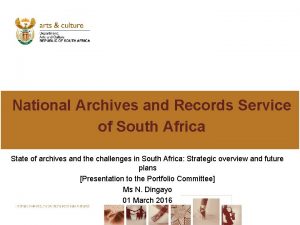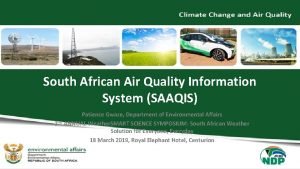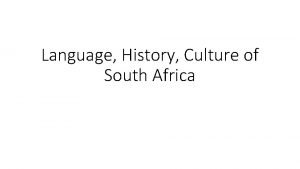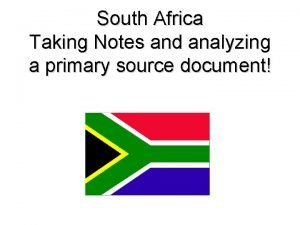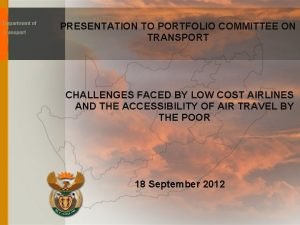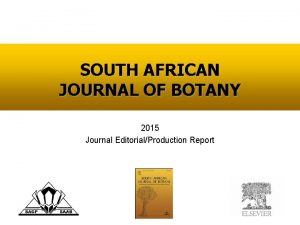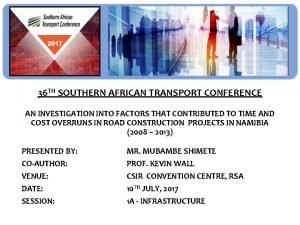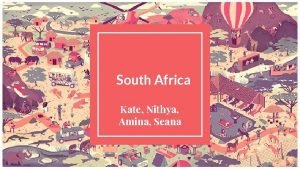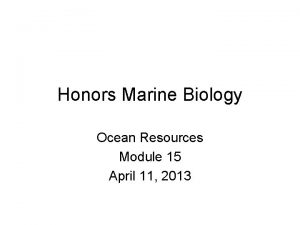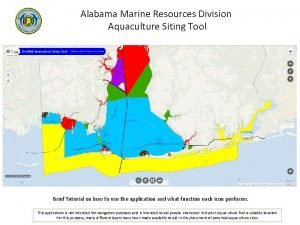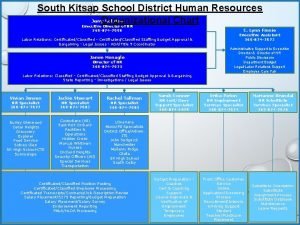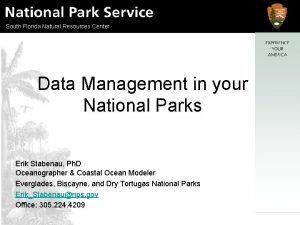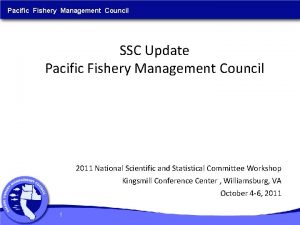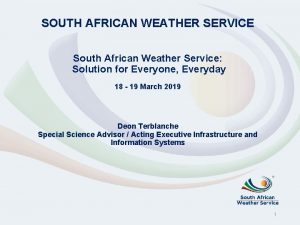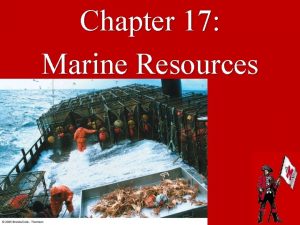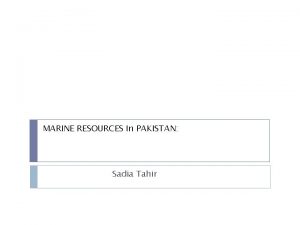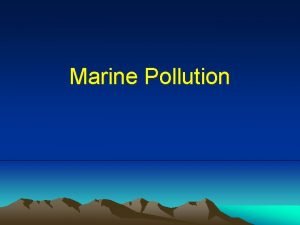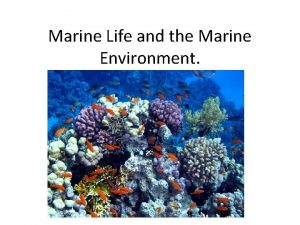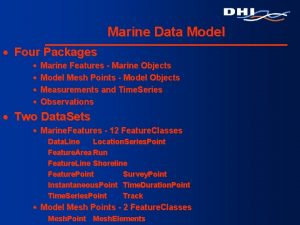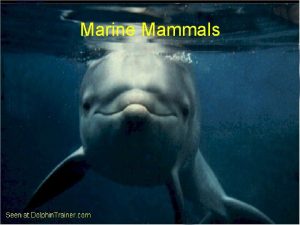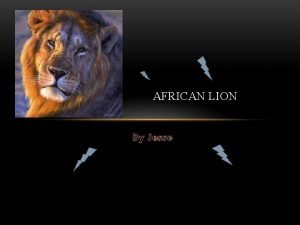STATUS OF THE SOUTH AFRICAN MARINE FISHERY RESOURCES





















- Slides: 21

STATUS OF THE SOUTH AFRICAN MARINE FISHERY RESOURCES 2016

INTRODUCTION Ø This report is a summary of the collective effort of the research team in the Fisheries Branch of the Department of Agriculture, Forestry and Fisheries Ø The Status of the South African Marine Fisheries Resources Report covers all of the managed fishery resources Ø For each resource it provides: - A quick-view assessment of resource status - An introduction to the resource - Information on history and management - Details of research and monitoring - Updates of current status and future projections Mandela Day Celebrations at the Seapoint Research Aquarium 2

TODAY’S PRESENTATION Ø Presents a summary of the status of the marine fishery resources as a whole Ø Provides a detailed overview from the report on key resources: - Cape hakes - Abalone - West Coast rock lobster A South Coast rock lobster has its vital statistics recorded 3

Abalone St Joseph shark SUMMARY Heavy Oysters (S. Cape) Ø The stock status gives an Squid Albacore (Ind. ) Bigeye tuna (Ind. ) indication of the current status, resulting from past fishing activities • Healthy & optimally utilized = 37% • Under utilized & unsure = 13% Optimal Harders Elf White steenbras Soupfin shark Longfin mako shark Southern bluefin tuna (Ind. & Atl. ) Yellowfin tuna (Atl. ) Deep-water hake Silver kob Sardine Horse mackerel West Coast Yellowtail (line & net) Shallow-water Snoek rock lobster hake Carpenter Prawns (shallow. Slinger Prawns (deep-water) Albacore (Atl. ) Bigeye tuna (Atl. ) Swordfish (Ind. ) South Coast Kelp rock lobster Anchovy Light • In trouble = 50% (serious trouble =28%; moderate trouble = 22%) Swordfish (Atl. ) Patagonian toothfish Unknown Ø Of the 49 stocks assessed for the 2016 report: FISHING PRESSURE Oysters (KZN) Ø Fishing pressure describes the current level of fishing on resource Yellowfin tuna Smoothhound shark (Ind. ) Blue shark Agulhas sole Oceanic white-tip shark Redeye Seaweed (non-kelp) Great hammerhead shark Hottentot seabream Red steenbras White mussel Unknown Seventy-four Abundant Optimal STOCK STATUS Depleted Heavily 4 depleted

2016 2014 25 2014 15 5 2016 10 2016 20 2014 Percentage of stocks 30 2016 35 2014 40 2016 COMPARISON WITH TWO YEARS BEFORE – gains and losses 0 Unknown Under-utilized Optimally-utilized Concern Over-exploited 5

WHY THE CHANGES BETWEEN YEARS? Deterioration in the status of a fish stock: • Squid – status has deteriorated for unknown (perhaps environmental) reasons, but insufficient data are available to perform accurate assessments or determine probable causes, so much uncertainty remains • Indian Ocean yellowfin tuna – Indian Ocean Tuna Commission (IOTC) advises that status has deteriorated due to unsustainable fishing pressure and proposes 10 -15% reduction in effort • Indian Ocean bigeye tuna – IOTC advises that status has deteriorated due to unsustainable fishing pressure Improvements in the status of a fish stock: • Deep-water hake – has improved in response to the recovery plan developed by the Demersal Scientific Working Group and implemented by the Fisheries Management Branch over the past years • Anchovy – has shown a natural increase in response to recent good recruitment events • Linefish: carpenter, hottentot seabream & slinger have improved 6

WHY THE CHANGES BETWEEN YEARS? Continued… Improvements in the perception of stock status (due to improved data and assessments): • Hottentot seabream (linefish) – improved assessment by Linefish Section • Carpenter (linefish) – improved assessment by Linefish Section • Slinger (linefish) – improved assessment by Linefish Section • Yellowtail (linefish) – improved assessment by Linefish Section • Indian Ocean swordfish – improved data and assessment by IOTC • Indian Ocean albacore – improved data and assessment by IOTC • Atlantic Ocean albacore – improved data and assessment by International Convention for the Conservation of Atlantic Tunas (ICCAT) 7

CAPE HAKES Ø Fishery catches shallowand deep-water hakes together Ø Caught by trawl (inshore & offshore), longline and handline Ø Value equals that of all other SA marine fisheries combined Ø Deep-sea trawl is the only South African fishery certified by the Marine Stewardship Council and was recently recertified by the MSC 8

CAPE HAKES …. . Ø 2006 assessments indicated no problems with shallow-water hake, but indicated that deep-water hake was over-exploited Ø A recovery plan in the form of an Operational Management Procedure (OMP) aimed at recovering biomass of deep-water hake was implemented Ø TACs were substantially reduced for a few years (2007 -2009), after which the resource responded positively, and recovered faster than had been anticipated Ø As a result catch rates have increased, as have TACs Ø Current management aims to keep the resource around the Maximum Sustainable Yield Level (MSYL) 9

PELAGIC - TOTAL BIOMASS AND RECRUITMENT Ø Time-series showing annual estimates of total biomass (histograms) and recruitment (circles and lines) from hydro-acoustic surveys, 1984 -2015 Ø Anchovy: total biomass during November 2015 survey estimated at 1. 9 million tonnes; slightly below long-term average of 2. 28 million tonnes. Recent recruitments good Ø Sardine: total biomass during November 2015 survey estimated at 363 000 tonnes; well below the long-term average of 968 700 tonnes and following 5 successive years of poor recruitment Ø Redeye round herring: total biomass during November 2015 survey estimated at 1. 3 million tonnes; above long-term average of 967 200 tonnes. Recent recruitments very good. 10

PELAGIC FISH ANNUAL CATCHES Catches of sardine, anchovy and west coast round herring by the small pelagic fishery, 1949 -2015; landings dominated by anchovy 11

PELGIC FISH ANNUAL TACs AND CATCHES Anchovy TAC again under-caught in 2015; industry claim changes in anchovy behaviour have reduced catchability and new air pollution legislation has constrained processing Sardine TAC fully caught in 2015 Redeye round herring PUCL substantially undercaught in 2015 (fish availability, preference for anchovy) 2016 TACs and catches to 9 th November 2016: Anchovy: TAC = 450 000 t; catch = 261 407 t Sardine: TAC = 66 375 t (low level due to low sardine biomass); catch = 61 282 t Redeye round herring: PUCL = 100 000 t; catch = 53 599 t 12

ABALONE Ø Resource has suffered serious decline despite best efforts at management (e. g. closure of recreational fishery, drastic TAC reductions, area closures, TURF system) Ø The recreational fishery was closed in 2003 Ø The commercial fishery was closed in 2008 Ø Commercial fishery was conditionally re-opened in 2010 Total allowable catch (TAC) and recorded (legal) annual landings for the abalone fishery from 1953 to 2015/2016. Landings for the recreational sector are only available since 1988/1989. Note that the substantial recent illegal catches are not shown. 13

ABALONE …. . Zones A & B (Gansbaai to Buffeljags) Ø Assessments indicate that the resource continues to decline in these Zones Ø Projections show that the resource will continue to decline at the current rate of harvesting Ø The major contributor to this decline is illegal harvesting Ø Projections further indicate recovery is possible if major reductions in illegal harvesting can be achieved Total (inshore + offshore) spawning biomass projections for Zones A and B. The 20 year projections shown after the vertical line represent four different scenarios for resource status under future commercial and poaching catches. Unless a zero amount is assigned, future poaching levels are assumed to remain at the current estimated level (average of 2015 and 2016 estimates) and future commercial catches in each of these two zones are set to the current TAC of 20 t. The bottom plots zoom in on a shorter period to be able to distinguish the curves more clearly. In each plot, the required reduction in poaching necessary to keep the resource stable at its present level under the current TAC is also shown, with the required reduction indicated in the legend 14

ABALONE …. . Other Zones Ø Zones C& D (Hangklip to Hermanus) - The resource is continuing to decline due to poaching - The incursion of rock lobsters since the early 1990 s has caused an ecosystem shift, hampering recruitment of young abalone and compromising the ability of the resource to recover in these Zones - Zero TACs are currently being maintained in these zones Ø Zones E, F & G (West Coast) - Resource indicators suggest no reason to change catch allocations in these zones Abalone in their natural environment - Estimates of possible stabilisation in poaching over the last 2 years were noted in these zones - The natural productivity and reproduction are low here, compromising the ability of the resource to recover in these zones 15

WEST COAST ROCK LOBSTER Ø The fishery generates around R 260 m per year, and employs about 4 200 people West Coast rock lobster fishing zones Ø The fishery has traditionally focused on the West Coast, but resource shifts in the 1990 s resulted in three new areas being opened up East of Cape Hangklip Ø The fishery consists of the following sectors: - Offshore commercial (traps) - Inshore commercial (hoop-nets) - Interim relief - Recreational 16

WEST COAST ROCK LOBSTER …. . Ø Declines in catches since the 1950 s-1960 s have had a number of causes, including: - Changes in fishing methods - Stricter control of catches - Declines in resource abundance - Reduced growth rates - Environmental changes Historical catches of West Coast rock lobster, with the associated trend in growth indicated for the period post-1960. 17

WEST COAST ROCK LOBSTER …. . Ø The resource is currently severely depleted. It is estimated that the resource is currently at 2. 5% of pre-fished levels Ø The current recovery plan aims to recover the resource by 35% by 2021, i. e. to 4. 8% of pre-fished levels by 2021 Ø The global TAC for the 2015/16 season was set at Ø 1924. 5 t in line with the recovery plan. A catch of West Coast rock lobster 18

CONCLUDING – THE BAD NEWS Ø Many of our key marine fishery resources have been over-fished in the past Ø In particular, our nearshore resources are under extreme pressure Ø Our resources are therefore impoverished and catches are often far less than they could be 19

CONCLUDING – THE GOOD NEWS Ø Wild fish stocks are not doomed to dwindle down to nothing Ø With wise management, something can be and is being done Ø Our experience (for example with deepwater hake) has shown us that recovery plans can provide positive results Ø This can lead to greater productivity of fish stocks and substantially larger catches of certain resources Ø By implementing resource recovery plans, we can achieve gains that will make a significant positive contribution to food security and alleviating coastal poverty A good snoek catch brings smiles to the faces of fisherfolk in the Western Cape 20

THANK YOU 21
 Sa national archives
Sa national archives South african council for the architectural profession
South african council for the architectural profession Saaqis
Saaqis South african council for natural scientific professions
South african council for natural scientific professions The south african apartheid
The south african apartheid South african freedom charter pdf
South african freedom charter pdf Furniture industry south africa
Furniture industry south africa South african principals association
South african principals association South african bont tick
South african bont tick South african tax
South african tax South african journal of botany impact factor 2020
South african journal of botany impact factor 2020 Seamless southern africa
Seamless southern africa South african transport conference
South african transport conference South african tax
South african tax Hamilton surgeon
Hamilton surgeon 1994 apartheid
1994 apartheid 2.15 quiz: marine resources
2.15 quiz: marine resources Alabama marine resources division
Alabama marine resources division Old south vs new south streetcar named desire
Old south vs new south streetcar named desire Central kitsap school district human resources
Central kitsap school district human resources South florida natural resources center
South florida natural resources center Renewable resources vs nonrenewable resources
Renewable resources vs nonrenewable resources
